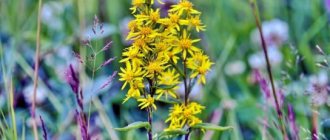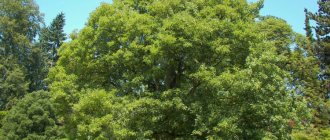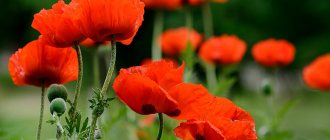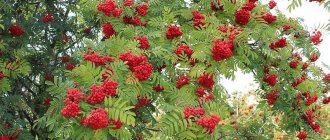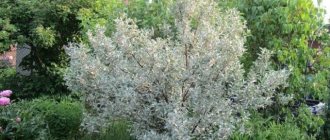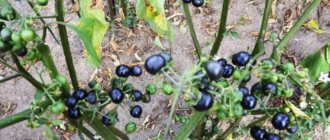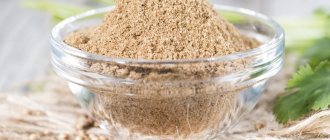Lingonberry (Vaccinium vitis-idaea) is a berry-bearing evergreen shrub. This species is a representative of the genus Vaccinium; in nature it is distributed in tundra and forest zones. This shrub prefers to grow in mixed, coniferous and deciduous forests, peat bogs, mountain and lowland tundras. Lingonberry is found in Western Europe, Northern Mongolia, North Korea, European Russia, East Asia and Manchuria. The name of the species is translated from Latin as “grapevine from Mount Ida” - this place is located on the island of Crete. The first mention of the genus name was found in sources of the 16th century, and lingonberries began to be cultivated more than a century ago in America. Around the same time, the first appearance of varieties of this crop occurred. In Europe, this plant began to be cultivated only in the sixties of the last century. Today, in Lithuania, Russia, Belarus and Germany, medicinal or common lingonberries are grown on an industrial scale. Not so long ago, lingonberries began to be grown on an industrial scale in Scandinavian countries.
Types and varieties of plants, appearance
Red refreshing berries grow on an evergreen low-growing shrub up to 15-25 cm tall. The shrub grows, spreading creeping horizontal roots along the ground. Shoots emerge from the roots, sometimes reaching up to a meter in length, so each bush grows next to the others.
The photo of lingonberries shows that the leaves of the plant are dense, matte, and oval in shape. Common lingonberry blooms in late spring - early summer, the flowers are collected in neat clusters. The fruits ripen in August – September. These are shiny red berries up to 7-8 mm in diameter. After the first frost, the sweet and sour dense fruits become soft and fall from the bush with a simple touch.
Berries of Russia
As noted above, this culture appeared in Russia in the 1960s. Typically, the area of distribution of shrubs covered with smooth leathery leaves is thickets of other shrubs, peat bogs and alpine meadows. A lot of lingonberries can be found in the forest.
Where do lingonberries grow in Russia today? Its habitat is mainly mixed coniferous forests (spruce, pine, larch), and sometimes deciduous forests.
As for where lingonberries grow best, these are mostly flat areas, mountain taiga belts and coniferous forests of the Far East and Altai. In addition, you can often find entire growths of this amazingly tasty sweet and sour berry in the tundra and forest-tundra.
This necessary and useful plant grows even on the cold shores of the Arctic Ocean and in the harsh conditions of the Urals. Lingonberries can also be found in the Caucasus Mountains, Karelia, and the Arkhangelsk and Murmansk regions.
The swampy areas of the forests of northern Russia are also a good place for lingonberries. Now let’s look at the Moscow region in more detail.
Lingonberry: beneficial properties
Lingonberry belongs to the vitamin, melliferous, food, medicinal and ornamental plants. Berries are consumed both fresh and processed. They are used to prepare fillings for sweets, compotes, jams, marmalades, pastilles, juices, extracts, marinades, and drinks. High nutritional and taste properties are due to the presence of sugars, organic acids, pectil and tannins, oils and vitamins.
In pharmacology, the antiseptic and anti-inflammatory effect of lingonberry leaves is used. Lingonberry berries are used in folk medicine in their entirety: both leaves and fruits.
As a honey plant it produces up to 50 kg of honey per hectare. And red berries combined with lush greenery look beautiful on decorative stone slides.
General information
Legends have always been made about this magical berry. It had a rather impressive and appropriate name - “berry of immortality.”
In this article you can see and learn a lot of interesting things about this amazing berry called lingonberry: photos of where it grows, description, properties, etc. Also here, the Moscow region areas rich in thickets of the miraculous plant will be described in more detail.
One of the most famous healthy berries, revered by many, belongs to the group of medicinal plants.
Application
In cooking
Lingonberries are valued for their refreshing taste; delicious drinks (fruit drinks) are prepared from the berries and leaves. This drink does not spoil for a long time in a cold place.
The berries are sprinkled with sugar and used to make jam and a filling for sweets. Lingonberry jam has become a traditional delicacy in Scandinavian countries.
Pickled lingonberries have a pleasant piquant taste. It is added as a side dish to meat and fish dishes, and salads are decorated with red berries.
In medicine
Medicinal substances are concentrated mainly in the leaves. They are prepared before mid-May or already in the fall, after picking the berries. A decoction of the leaves has a diuretic effect and is used as an antiseptic and astringent. The decoction helps with gout, arthritis, cystitis, and urolithiasis.
The berries are used in the treatment of low-acid gastritis and hypertension. Juice from the berries reduces blood pressure, calms the nervous system, and enhances intestinal peristalsis. Fresh berries are used as a laxative, anthelmintic, bactericidal and choleretic. Thanks to a bouquet of vitamins, lingonberries are a useful element of the diet for vitamin deficiency.
When losing weight
Lingonberries are rich in sugars, acids, vitamins and microelements. Lingonberry juice quenches thirst well, restores the balance of substances in the body, and gives a slight laxative effect. Lingonberry juice is drunk for constipation and liver diseases. And lingonberry tea (dry leaves brewed with boiling water) relieves fatigue and restores strength.
At home
In everyday life, lingonberries are a tasty, nutritious product. Ripe berries are eaten to prevent vitamin deficiency. And the berry infusion is given at a temperature, as it quenches thirst well and prevents dehydration. Aromatic tea made from dried leaves is an excellent natural relaxant. It restores strength and relieves fatigue.
In cosmetology
Masks and tonics are made from berries. Lingonberry is suitable for normal and oily skin, helps against wrinkles and spider veins (rosacea). Here are some examples:
- mask for tired oily skin: 2 tbsp. l. lingonberry juice is mixed with whipped egg white and applied to the face for 15 minutes, and then washed off with warm water;
- anti-wrinkle mask: grind 1 tbsp. l. berries with 1 tbsp. l. sour cream. Apply to face for 15 minutes, rinse with warm water;
- for rosacea, the berries are mixed with starch in a 1:1 ratio and applied to problem areas for 15 minutes and then washed off.
Lingonberry juice relieves inflammation, tones and refreshes the skin, and reduces the vascular network on the face.
Soil preparation
You can grow lingonberries in your garden plots in the same way as garden blueberries. To do this, an acidic soil environment is prepared, and several bushes are planted in the planting hole. The land for each plot must be prepared as follows:
- 1 square meter of the top layer is removed with the bayonet of a shovel;
- On oilcloth or in a stretcher this layer is mixed with red acidic peat and sand;
- The prepared mixture is poured into the hole, then trampled down and wetted well.
Harm and contraindications
Beneficial lingonberries can become harmful and even dangerous in one case. The plant easily and in large quantities accumulates harmful substances. Therefore, you can only use those berries and leaves that are collected far from roads, industrial zones and cities.
Lingonberries are contraindicated for people with hypotension: the berries reduce already low blood pressure. People with ulcers also need to be careful: lingonberries contain many different acids.
Watering
It is preferable to provide regular watering, or even better with rainwater, to reduce carbonate content. Every week it is necessary to add acid to the irrigation water, in spring and autumn add acidic peat, sawdust and pine litter in the form of a mulching layer.
It has been noted that sprinkling irrigation is less favorable than drip irrigation. Apparently, for their survival, heathers and lingonberries actively grow beneficial fungi in the root zone, and sprinkling from above causes damage to the upper part of the plants by parasitic fungi.
Nutritional value and chemical composition
For every 100 g of berries there are only 46 kcal. Therefore, by eating lingonberries, you saturate your body with useful substances, not calories.
The plant contains organic acids (malic, citric, salicylic), glucose, fructose, and trace elements (iron, phosphorus, magnesium, potassium, manganese). And thanks to benzoic acid, the berries have preservative properties.
Landing conditions
Lingonberry is a light-loving plant, so choose sunny places for planting. The more sun the bush receives, the more abundant the harvest will be. The soil should be light, acidic (pH=3.0-5.5) and moist. Sandy loam soil with the addition of peat is more suitable. Lingonberries do not grow in clay areas. To prevent plant roots from suffering, groundwater must be deeper than 2 m.
It is better to plant lingonberries in mid-April, but you can also plant them in late autumn. Weeds are removed from the site and dug up with fertilizers. It can be superphosphate, potassium sulfate. Then the ground is leveled and planting holes are made at a distance of 30 cm. Experienced gardeners advise adding soil from natural lingonberries, which is rich in spores of saprophytic fungi, when planting in a hole.
The plant is carefully removed from the transport pot and, without clearing the ground, placed in a hole, deepening the root collar by 2 cm. Then the plantings are watered abundantly and mulched with sawdust, high-moor peat or pine needles.
To increase the survival rate of seedlings, they are protected with covering material until complete rooting - on average for 2-3 weeks.
How to grow, care and pests and diseases
Large-scale cultivation of the crop began in the 60s of the 20th century in Europe and the USA. The yield of “domesticated” berries exceeds wild ones by 20 or more times. From one hundred square meters, lingonberry produces about 60 kg of berries per year. To increase productivity, rejuvenating pruning of all lingonberries is carried out every 4 years. Fluff the soil twice a season.
The most common lingonberry disease is a certain type of fungus. It affects the green parts of the plant: stem, leaves, shoots. Greens infected with the fungus curl, turn pale pink, and look like strange flowers. This is how lingonberries “rust”: some photos below show what this disease looks like. Other pests are leaf roller and honeymoon caterpillars that eat leaves.
Nowadays, breeders have developed dozens of productive varieties. Homemade lingonberries grow faster and more densely than wild ones, and their yield is higher. Water the bushes thickly, but do not flood them, avoid stagnation of water. Plant on a hill, in an open place, avoiding shade from trees. Every season, the soil must be acidified using acidic peat, a solution of water with vinegar or lemon juice.
Berry places in the Moscow region
Where do lingonberries grow in the Moscow region? In general, the vast forests of these places are very rich in a wide variety of berries: blueberries, cranberries, raspberries, wild strawberries, etc. And lingonberries have taken root here quite well.
This is not at all surprising, due to the fact that the southern spurs of the northern taiga reach here from the north, and from the south there is the northern border of the southern oak forests. It is at the junction of the boundaries of broad-leaved and coniferous forests that a diverse berry flora finds its refuge.
Favorite places for lingonberries are moss, peat bogs and heavily swampy pine forests. These are mainly the floodplain areas of the Suloti and Dubna rivers, as well as Meshchera in the area of the city of Shatura.
In addition, lingonberries also grow in other areas around reservoirs overgrown with peat. These are lakes Krugloye and Trostenskoye in the Lotoshino region.
In the above-mentioned places, usually up to a ton of berries can be collected from one hectare of cranberry swamp in a year. Moreover, the fruits are collected in three periods: September, the beginning of freeze-up, early spring (April). Lingonberries keep well throughout the winter.
This amazing berry, as noted above, prefers drier pine forests, burnt areas, clearings and illuminated edges. Therefore, the following forest areas of the Moscow region are very rich in these berries: northern regions - Zagorsky district; eastern - Noginsky, Orekhovo-Zuevsky and Kurovsky; western - Volokolamsk, etc.
How to plant seedlings in open ground
You can plant lingonberries in open ground in the spring, starting in April, when consistently warm weather sets in, and also in the fall before the first frosts appear. At the same time, in the spring, young plants are most often covered with non-woven materials to protect them from possible frosts.
It is advisable to plant lingonberries after the average daily temperature has stabilized above +5°C
This is interesting: Urea (carbamide): concept, composition, instructions for use
It is best to use seedlings 2-3 years old for planting. They almost always take root and begin to bear fruit faster. The seedlings are planted in the beds along with the soil in which they grew. To do this, as a rule, depressions of 12-15 cm are made in the ground. Seedlings, carefully removed from a pot or box, are lowered into them. Then the earth is compacted a little, filling the top layer of soil in which the bush grew with soil from the garden bed. Small lingonberry cuttings are planted in the same way, but they are buried only 2-4 cm into the soil.
When planting from pots, the bushes are transferred directly with a lump of earth.
When planting seedlings, it is necessary to leave sufficient distance between them. The bushes should be 25 cm apart from each other, as they will grow. In addition, after a few years, as a result of natural division, young bushes may appear nearby.
After planting lingonberries, it is necessary to mulch the soil. You can use softwood sawdust, straw or fine gravel for this. They are laid on top of the ground in a layer of 2 to 5 cm. Mulch helps retain the necessary moisture, and sawdust and pine needles help acidify the soil.
According to gardeners, lingonberries need to be watered every day for the first 10 days, and then as needed. For irrigation, it is advisable to use rainwater or water that has stood for 1-2 days. For example, here is a video review of the autumn planting of lingonberries:
Correct fit
2-3-year-old seedlings of cultivated varieties are best planted in the spring, when the soil warms up to +5...+8 degrees. But autumn planting is also possible (September). Plants are planted 1-1.5 cm deeper than they grew before, according to the scheme 25-30×30-40 cm. Water abundantly.
Frost protection
Lingonberries are not afraid of frost and tolerate even snowless winters. However, with the onset of cold weather, it is recommended to cover the plantings with spunbond. This will prevent the plants from drying out in very cold and snowless winters. The greatest damage to the crop can be caused by early autumn frosts, during which unripe fruits are damaged. Abundant watering the day before, sprinkling or covering with any available material (spunbond, straw, fabric, spruce branches, foam rubber or plastic film) will help protect lingonberries.
The lingonberries in the photo look bright and also in the garden
Cranberries are decorative at any time of the year, as they do not shed their leaves in the winter. Rhododendrons look great between a cluster of conifers and a berry meadow. Eric and Eric are planted in the foreground. And to combat weeds, the soil around the plantings is thickly mulched with coniferous bark.
As you can see, cranberries grow in acidic soils and require moist, loose soil. Its bushes resemble boxwood bushes, which in September are decorated with beautiful large berries. An amazing plant with year-round decorative value and a number of useful properties.
